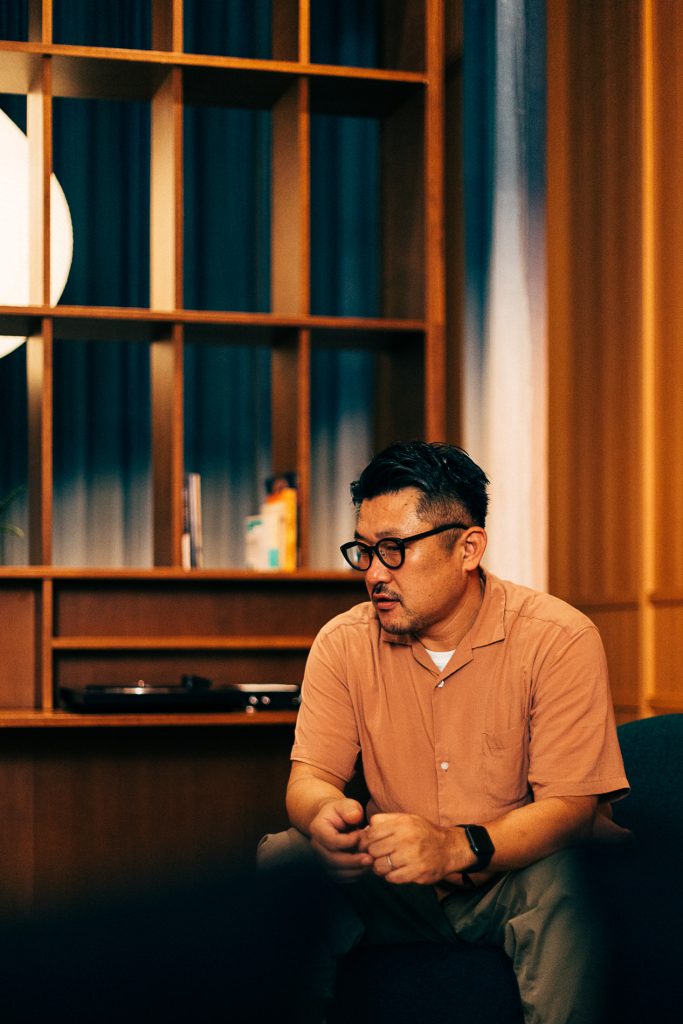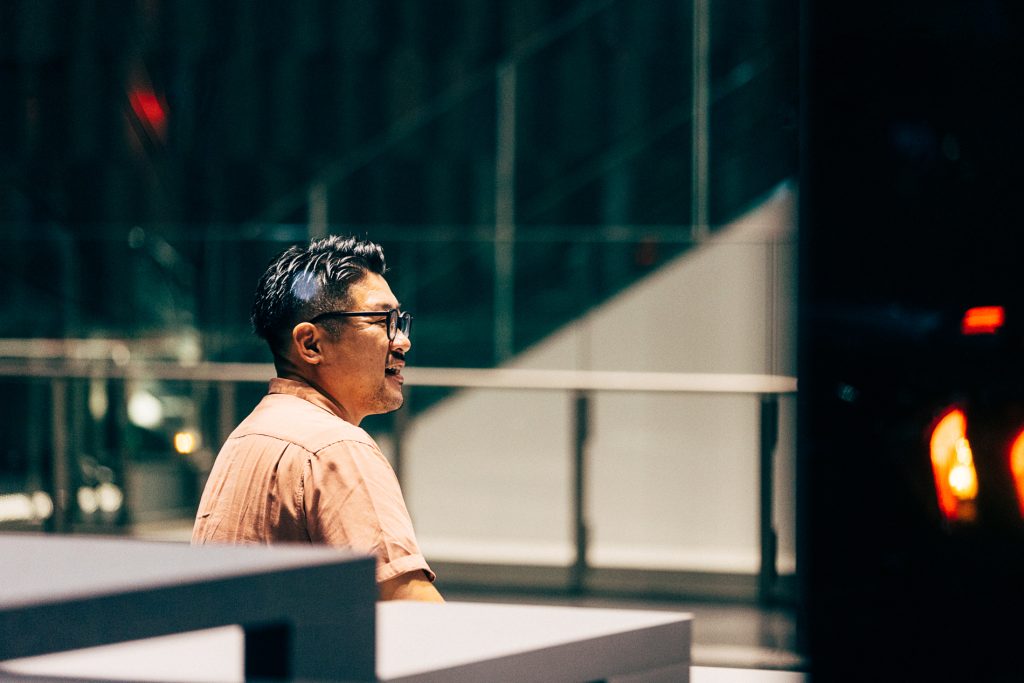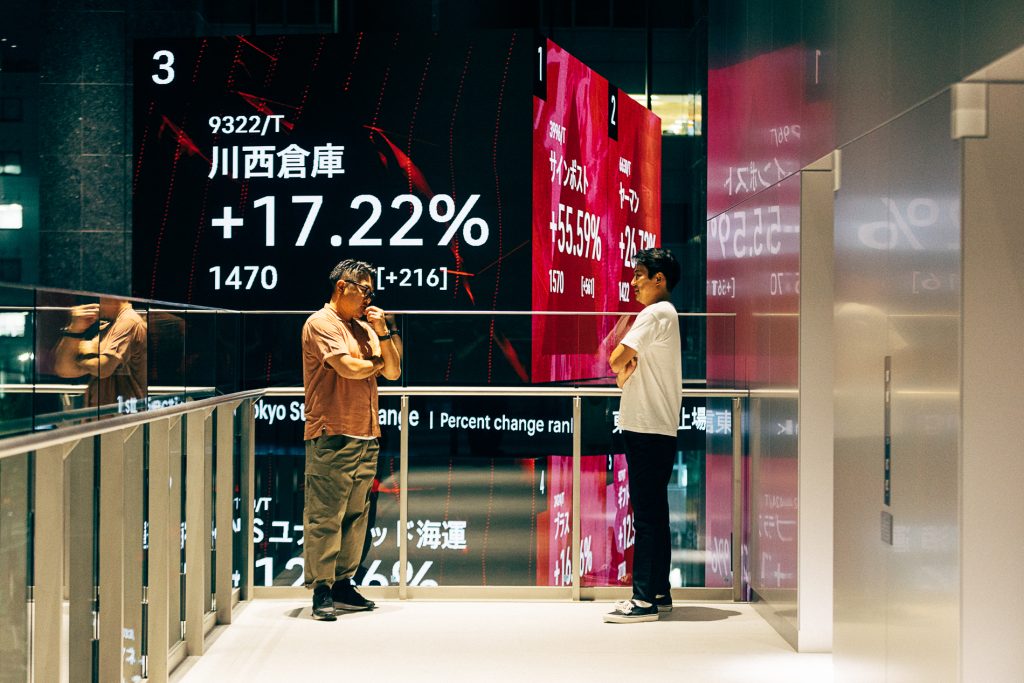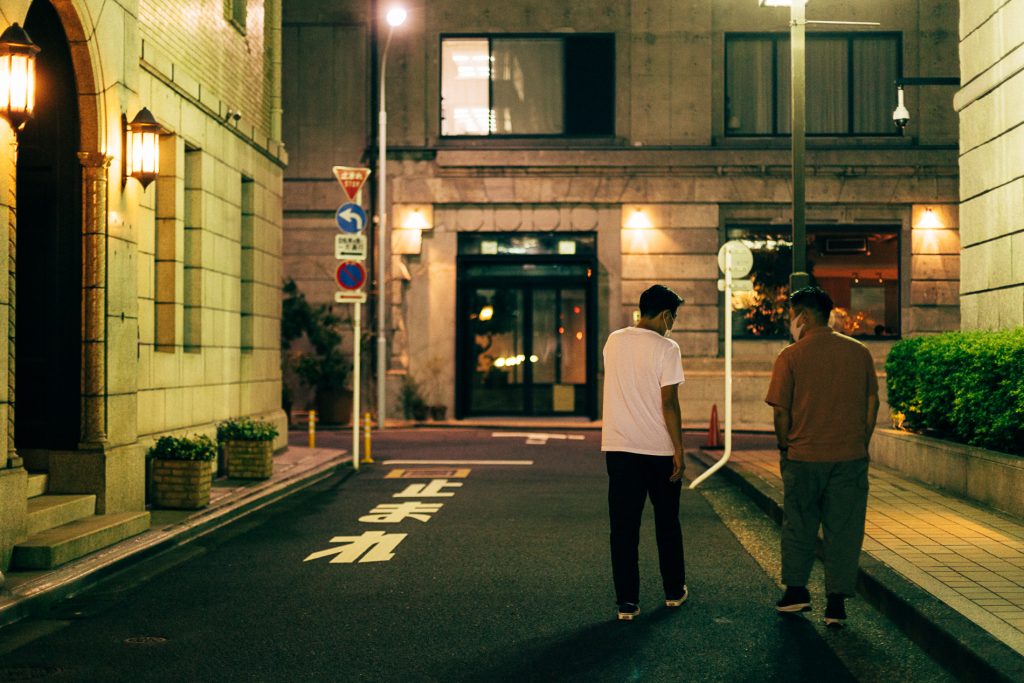


2021.11.10
Seiichi Saito
President of Panoramatiks (formerly known as Rhizomatiks Architecture)
HEART of the living dead
Half-human, half-zombie.
●Were you familiar with Kabutocho before working on this project?
Not at all! Of course, I knew the name, but I didn’t know much about stock trading before it became digitized, so I had very little knowledge. I had heard of glamorous lifestyles, but honestly, when I thought of the area, I had a stronger association of bars and places to drink.
●When did you first get involved with Kabutocho?
It’s been about three years since I started working on ‘The HEART’ project. I still remember when I was first contacted by DOPPEL (*1), a live painting team, about doing a mural in a building in Nihonbashi. I had the impression that Heiwa Real Estate would be keen to do something interesting. When Moment Factory (*2) first came to Japan, I went to meet the co-founder, Dominique Audette, for an interview on Nippon TV. I think that was also in Kabutocho.
※1 DOPPEL
BAKI BAKI and MON are a live painting duo based on the concept of “pursuing expression in the unit of two people” which is neither the individual nor society.
※2 Moment Factory
A Montreal-based digital art collective that has created art installations such as ‘Foresta Lumina’.
●What was your impression of Kabutocho?
As I started to attend meetings in the area, the image in my mind of Kabutocho became clearer every time, and my impression of the town and its appearance changed. I saw Heiwa Real Estate and Media Surf working together on the development of Kabutocho, including K5 Hotel, and it made me think about gradual change on a human scale. It was a good example of urban development.
●From the perspective of a consumer, things like craft beer and natural wine began to lay the groundwork of development. It’s this approach to urban development, a micro-perspective rather than a macro-perspective that has been crucial in building Kabutocho and is also the main theme of Kontext.
Yeah, I think that’s a very important point of view. On the other hand, I think that the renovation of buildings is also very important. The moment a building ceases to exist, its entire ecosystem and history are forgotten. It’s no good if it just becomes a legend, something that is the economic consequence of a large-scale city. By respecting its influence, even by leaving a single pillar, I believe it will help us to build better cities in the future.
Rather than labeling a city as a virtual space where nothing exists, I think it’s better to recognize that there are good restaurants or that people who are good friends are doing business there.
●When talking about urban development from a macro perspective, there is a certain language used to describe cities and their target audience. For example, Nakameguro has been developed as a town for young people. In this way, labeling Kabutocho as a finance town may in fact mask the positive aspects of the city.
I always thought that urban development was like collecting playing cards, where you match the cards based on their pattern or color. But in reality, it doesn’t work like that. No matter what city it is, or how good the attributes are unless there are people inhabiting the city, it will not attract people. It is only when there are people that a city can exist.
●Does it mean that a city that develops organically will be more interesting as a result?
Rather than labeling a city as a virtual space where nothing exists, I think it’s better to recognize that there are good restaurants or that people who are good friends are doing business there. It would be more natural if people with similar attributes were somehow attracted to the place. It’s already strange enough that visions such as creating innovation and culture are set up as KPIs (Key Performance Indicators).
●Since working on KABUTO ONE, you’ve started to look at Kabutocho from a micro perspective. Considering the attributes of this city, what elements do you think will be necessary for the future?
Chaos. The key is to do whatever you want, even if you have different goals. Some people go to eat Chinese food, and some people go to breweries to drink beer. Leaving aside considerations such as being the first in Japan or getting an electronics manufacturer to create a new flagship store, in the end, people will do what they want without much systematization. In any case, people’s actions can create a big swell. It’s a bit like how Williamsburg, New York was like in the past. On the other hand, isn’t it more important to not gather more of the same things? I guess the feeling is more like, “Let it go, do as you please.”
●I think it is the fate of cities, that eventually they will have to come to terms with gentrification. Have you found any interesting cities that are successful examples of urban development that are similar to Kabutocho?
If I had to say, I would say Williamsburg. It became gentrified, but that’s not necessarily a bad thing because it’s also a form of metabolism. I think that it’s more interesting to have people who are not from the same tribe. When I think about the new ideas and values that can sprout up when people of different backgrounds mix together, I start to get the feeling that for me, it may be more interesting to live in the countryside these days.
●How do you see the current situation in Tokyo?
I believe that Tokyo is in negative chaos. When we held the Tokyo Biennale (*3), there were so many entries that it was difficult to select the best works. At first glance, this may seem like a good thing, but on the contrary, it is also a bad thing. Everyone wants to be highlighted, so they keep enlarging their signs, and as a result, no one gets highlighted. This could also be referred to as; saturation. I think some people have a negative image of Kabutocho, that it lacks energy or places to shop. That’s why I think this is a great opportunity to create a city that is centered on the individual.
※3 Tokyo Biennale
An international art festival held once every two years in the city of Tokyo.
I needed to create an element that would allow people to actually feel the economy, and I decided to embody this sentiment as the heart of the Japanese economy in Kabutocho, the epicenter of the economy.
●Please tell us about The HEART.
The HEART was an idea that I presented in my first pitch. Personally, I believe that the two pillars of the future are “culture” and “economy”. But in Japan, culture has not been brought to the forefront. While I think it is difficult to quantify the conscious aspects of the economy, such as ecology and ethics, I felt that the economy itself was becoming invisible. That being the case, I needed to create an element that would allow people to actually feel the economy, and I decided to embody this sentiment as the heart of the Japanese economy in Kabutocho, the epicenter of the economy.
●I know there were many people involved, but how do you feel about the completion of the project?
There were some twists and turns, but I think we were able to follow a good workflow. We were able to reach our ‘North Star’, the vision that we eyed at the very beginning, and it took shape according to our intuition. I think that is also thanks to Heiwa Real Estate.
●Thinking about the themes of economy and culture, could you tell us about your vision of the future?
I often work with developers, but there is no proper think tank in Japan. So I am thinking of starting a ‘Think and Act tank’ that can take action.
●What is a ‘Think and Act Tank’?
I think this idea comes from something that is becoming more apparent due to the Covid situation; that being that our old ways of doing things no longer apply. For example, is it necessary to have a business plan for a 300 square-meter store? I think we are at a stage where we need to show where we are headed, and we need to accept new values. I don’t want to create a big think-tank team, but in order to present outcomes, I have been working with a researcher to study the evaluation guidelines for SDGs, urban planning, and mental health. I think it is important to be trusted from the beginning, including the sensory value, as we work with the government to create 3D maps. Recently, I’ve become old enough to be trusted by the people around me!
●Is age still a factor?
When you’re 30 years old, any idea you come up with is just one idea out of a thousand. But when you reach 40, the world around you changes quickly. It’s almost like you can see the social threads around you. It’s not an intention, it’s a thread. You start to see how to approach things. It may sound strange to say this but I just want to make the world a better place. I just want to make it the way it should be. If I’m rejected as an old man for saying this, I might start a mille-feuille shop next! The theory is that what was popular in New York, will become popular five years from now, so a mille-feuille shop might be a good idea!
●When that happens, I’ll be running a coffee shop next to it! But don’t you think that there is, at the same time, a landscape that you can see as you gain experience and a part of you that you lose as you get older? What do you think about the influence of young talents on culture and the city they create?
I’m sure it’s the same around you, but aren’t you often asked, “Have you seen any interesting young people lately?” It made me think what “young” actually means, and I realized that it’s not about age. And I don’t mean young people are inexperienced and don’t understand the adult world.
●What do you mean it’s not about age?
For example, when Radiohead (*4) came out, there was a debate about whether it was rock or not. I think the younger generations were the ones who could accept it as a completely new thing, rather than trying to categorize it or compare it to similar bands. Probably, values get bent when you try to apply them to something, so people who have the mind to interpret values in a new context are young. I believe that marketing theory has already collapsed, so we need at least one person like that for every ten people.
※4 Radiohead
An alternative rock band from Oxford, England. 2000’s “Kid A” and the following year’s “Amnesiac” were works that shocked the rock world and changed the direction of the genre. They will release “Kid A Mnesia” in November, on the band’s 20th anniversary.
I have been bitten by something zombie-like and am beginning to change, but I am still maintaining my spirit, weaving between people.
●You say that it is important to have a flexible mind, one that does not define value, so how do you envision the world in your mind?
I have been bitten by something zombie-like and am beginning to change, but I am still maintaining my spirit, weaving between people. In this way, I’m trying to see how the next society will be created. It’s a process of reconciling the gap with the real world.
●You have to understand the logic of both to be able to do this. I’d say that both the humanities and the sciences can verbalize creative ideas. I think the reverse is also true.
I can’t do this unless I understand both of their pains, but there is a part of me that looks at it like a game. I think of it as if I am solidifying the pieces of a jigsaw puzzle. The pieces don’t fit together, but I use a liquid to make them fit.
●What are some examples?
I’m looking at some merchandise for an event, but the design that was presented was not very good at all…… It’s a waste of money. If you’re going to spend that amount of money, there are better ways to do it, so it simply becomes a waste. I have a cynical view of the world. I’m always wondering, “why did they use that actor for the car commercial!”, such a waste! I want to avoid becoming a lump of discovery and vested interests, which is what adults are doing, so I have to think about how to proceed while keeping my eyes on the North Star as an outcome, not a vision.
●I think that the creative scene in Japan is structured in a way that makes it unprofitable.
When I was working in New York, I was paid twice as much as I am now. But in that sense, I feel that the standard for design and creativity in Japan is still backward. That’s why I’m trying to change it.
●The really important part is that we should give credit where it’s due.
The inevitable lack of emphasis on culture when talking about economics and culture is something that I think is going to change. Up until now, it has been difficult for creatives to assert themselves, especially when it comes to work commissioned by the government. I think that from now on, it is important for us to be open and communicative, to voice our opinions, and change the way that our work is evaluated.
● It takes a lot of courage, doesn’t it?
It’s quite important to speak out. There is a system that the government has called the “stage-gate system,” and we have an opportunity once a year for contractors to say what they think to each other.
I believe that a place that pursues only economic rationality will one day lose its value. I think we need to take a closer look at where the real value is.
●I would like to ask you about the margins of cities. For example, when I look at the signs in parks, I have the impression that they only list the things that you can’t do; just a long list of prohibited items or actions.
I often talk about how Japanese guards are not cool when it comes to the use of open spaces, but in Italy, as long as no one is bothering them, the guards in St. Mark’s Square just stand back and drink coffee. They basically tolerate anything as long as no one is harmed and it doesn’t get to the point where they have to take responsibility. I think that is the distance between people and social trust, but since Japan outsources guards to the private sector it’s different. I think the park management system in Japan has to be changed. I think it would be better to create a looser, freer society that will help us rethink social boundaries.
●So you think it’s better to leave a little more room for flexible interpretation, or a little more room for ambiguity?
I believe that parks have started to change a lot recently, but the margins are also at the mercy of development. I think Shibuya used to have a lot of space, but the recent development has put an end to it. What I like about Umikaze Park in Yokosuka is that there is a skateboard park there, and there is a kind of implicit consent.
●What do you mean by implicit consent?
Skateboarding had a reset moment when it became an Olympic sport. Before that, it was looked down upon by society. But the skate community is strong-willed. Skateboarding had a reset moment when it became an Olympic sport. Before that, it was looked down upon by society. But the skate community is strong-willed and they are able to communicate well with each other. They’ll say to each other things like, “you’re not quite ready for this yet”, or “I’ll teach you, so come back when you’ve mastered the ramp”, or “never bring a skateboard to the tennis court!”. So in a lot of ways, the skateboard community is formed and functions much like a city. There are no strict boundaries and so there is a certain distance and space that people have from each other that allows them to create a functioning community. It would be great to create a space like this or to make this a necessary function of parks, but the funding to do such a thing is just not there.
●A world where only economic rationality is prioritized without preserving culture really makes you think.
As far as Shibuya is concerned, the seniors who have set up their base in Shibuya are not even angry anymore. They don’t even care about it anymore, which means that Shibuya is no longer Shibuya, or that the gears have gone out of whack. But I don’t even want to change it back. Whether to take it as evolution or regression, I’ve come to think of it as evolution and how to make the best of what we have.
●We can only move forward by accepting it positively as an evolution.
I believe that a place that pursues only economic rationality will one day lose its value. I think we need to take a closer look at where the real value is. That’s why I’m always going in the direction where the money is not!
●I hope that Kabutocho will be able to create an organic city without large-scale redevelopment while continuing to grow itself.
Rather than destroying it and building a new building, an old building is much more attractive. And it would be nice to have a place that has depth, that has two sides. Something that is not only interesting on sunny days, but a place that keeps true to its original elements, somewhere that still has a bit of chaos.

Seiichi Saito
Born in Kanagawa Prefecture in 1975. Graduated from the Department of Architecture, Faculty of Science and Technology, Tokyo University of Science. Studied architectural design at Columbia University’s School of Architecture (MSAAD) and began working in New York in 2000, working as a creative at the Arnell Group, part of the Omnicom Group, before returning to Japan in 2003 where he was selected as an artist for the Echigo-Tsumari Art Triennial. After working as a freelance creator, he established Rhizomatiks Inc. in 2006 (Currently Abstract Engine Co.) and has been running Rhizomatiks Architecture since 2016 and changed name to Panoramatiks in 2020. Currently working as a planning and implementation advisor for several governments and corporations. This summer, he designed the content for “The HEART,” a cube-shaped LED display for KABUTO ONE, a complex facility completed in Kabutocho, Nihonbashi.
Text : Jun Kuramoto
Photo : Naoto Date
Interview : Akihiro Matsui



